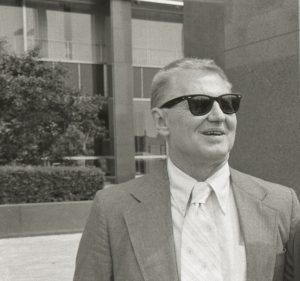
Photo info …
Credit: University of IndianapolisView Source
(July 29, 1920-Oct. 5, 1995). One of the key political figures in Indianapolis’s rebirth during the 1960s, Thomas Hasbrook was a long-time public servant, primarily in Indianapolis government. Born in Fort Wayne, Indiana, Hasbrook received most of his high school education in Indianapolis. A graduate of Indiana University, Hasbrook was a Marine during World War II.
Blinded in a stateside explosion in 1944, Hasbrook soon found himself with a profoundly different life trajectory and one that was at first tied to his loss of sight. Employed for more than 30 years by , Hasbrook made his foray into politics when he demonstrated the use of seeing-eye dogs for the Indiana General Assembly in 1945. Soon, Hasbrook was serving in state government, first in the Indiana General Assembly between 1951 and 1955, followed by the state senate from 1955 to 1958. His tie to city politics, however, is where he made his most influential mark.
First elected to the Indianapolis Common Council in 1960, Hasbrook was a key participant in the consolidation that passed the general assembly in 1969. As one of the handful of men who had helped dream up Unigov during the preliminary stages in 1968, Hasbrook faithfully served with Dr. as cochairman of Mayor 1968 task force to improve government structure in Indianapolis. The recommendations by the task force constituted the first public consideration of what become the Unigov legislation in 1969. That group made a number of compromises in order to secure passage of the bill, including rejecting the simultaneous consolidation of metropolitan school districts. Although Hasbrook agreed with the decision, he said: “the reason we are not willing to tackle schools is perhaps that we are cowards.”

Following the city-county consolidation in 1970, Hasbrook served as council president until 1975. Here Hasbrook worked closely with Mayor Lugar to enact a series of reforms that significantly reshaped the city. Between 1975 and 1978 Hasbrook served as deputy mayor for the city, first under Lugar and then under . Hasbrook was one of three Republican leaders who had hoped to follow Lugar into the mayor’s seat. Instead, he worked alongside Hudnut, who had been his rival in trying to secure the Republican nomination.
Hasbrook was of a handful of Republican leaders who had already enjoyed electoral success prior to the party’s 1966 reinvigoration, spearheaded by the Republican Action Committee and . Like his contemporaries SerVaas and Bulen, Hasbrook served as a generational bridge between older members of the Republican power structure, such as businessman , and the younger generation of leaders, embodied by Lugar. As part of the ticket that got elected with Lugar in 1967, Hasbrook, like many local Republicans, was tied to the transformational experience.
After a stint in the mayor’s office, Hasbrook headed the Marion County Hospital Association until 1983. He continued board service after his retirement.
, an organization committed to advocacy for the visually impaired, sponsors an award luncheon named after Hasbrook. Two years before his death, the Marion County Health and Hospital Building on 3838 N. Rural St. was renamed in his honor.

Help improve this entry
Contribute information, offer corrections, suggest images.
You can also recommend new entries related to this topic.

